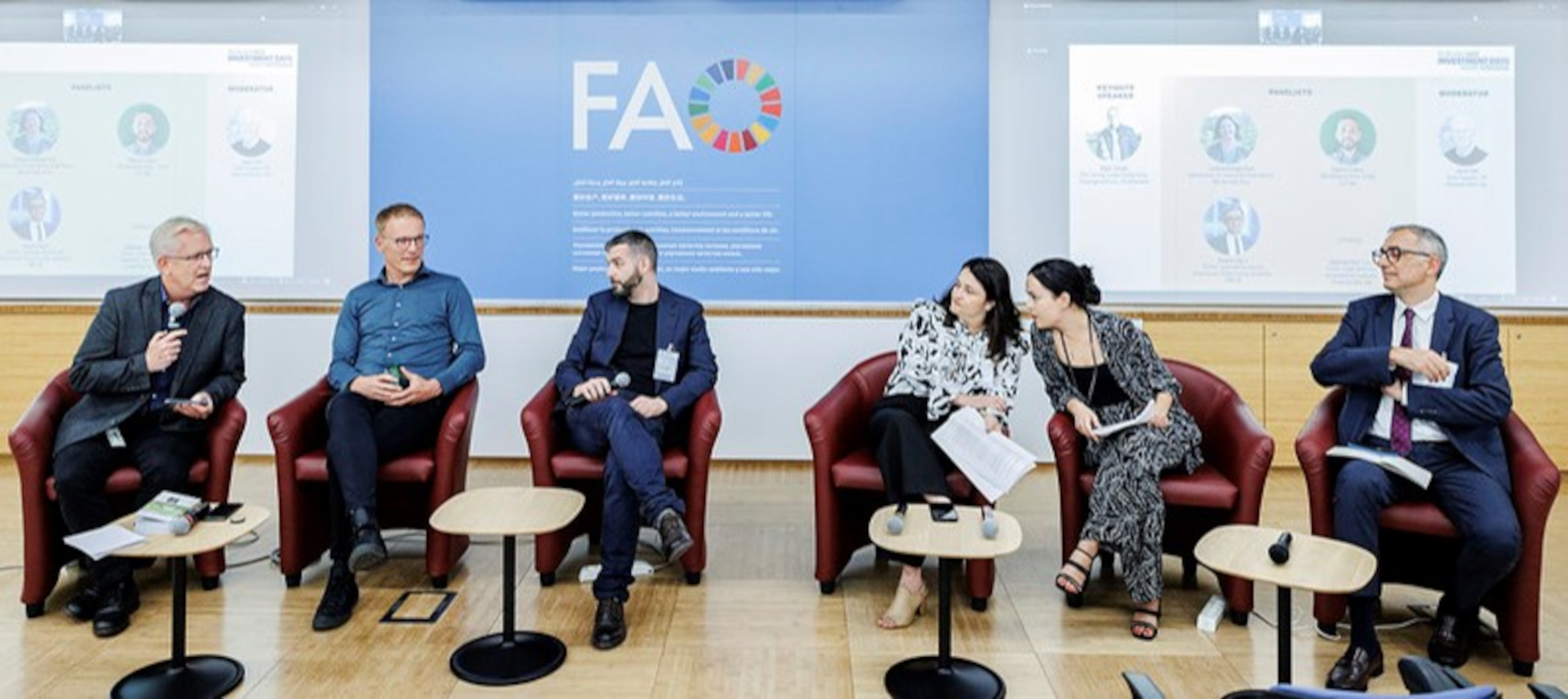Scaling up innovative solutions for sustainable agrifood systems

From climate change and biodiversity loss to rapid urbanization, changing diets and unsustainable production practices, the world’s agrifood systems are under pressure.
How can we make them greener, healthier and more inclusive?
More specifically, how can we translate the principles of economic, social and environmental sustainability into the policies and investments needed to ensure these systems work for people and the planet?
Earlier this year, participants at the FAO Investment Centre’s annual Investment Days took a deeper look at these questions, sharing innovative solutions for more sustainable agrifood systems.
FAO Senior Economist James Tefft, who moderated the session, said, “When we think of agrifood innovations, our minds usually turn to technology. Technologies are important, but we need to think much more broadly and look also at examples of social, institutional, financial and policy innovations.”

Resilience the new efficiency
The panel’s keynote speaker, Rogier Schulte Chair of the Farming Systems Ecology Group at Wageningen University, noted that if disruption from shocks – climate shocks, socio-economic shocks, public health shocks – is the new normal “then resilience is the new efficiency.”
His team has created a global network of lighthouse farmers to learn from their innovative solutions and identify common ingredients for their success.
“We call them lighthouse farmers because they’re already farming as if it were 2050,” Schulte explained. “They're like beacons, illuminating the way for others to follow.”
He shared examples of how farms in Latvia and Finland have created smart and integrated food and bioenergy production systems, redefining how we think about circularity and the potential for thriving rural and urban hubs.
“We’ve learned to let go of the idea of main products and by-products,” Schulte said. “It’s about closing cycles, not only of nutrients but also of biomass, energy and ultimately value.”

How cities are taking the lead
Cities across the globe, like Brazil’s Belo Horizonte, are taking the lead in finding innovative ways to tackle emerging food issues.
Darklane Rodrigues Dias, Undersecretary for Food and Nutritional Security in Belo Horizonte, spoke of how the city’s pioneering food policy is contributing to improved nutrition, generating income for producers and preserving biodiversity and the environment.
The integrated approach, which has been an example for the country’s Zero Hunger Strategy in 2003 and later its National Policy on Food and Nutrition Security, rests on three pillars.
The first is centered on the direct provision of nutritious and balanced subsidized meals in popular restaurants, school meals, food assistance to social welfare and citizenship organizations, and maintenance of the municipal food bank.
The second involves regulating the market to provide the population with healthy food at low cost in markets throughout the city specializing in organic foods and produce from local family and urban farmers.
The last pillar entails promoting family farming and urban agriculture – expanding the productive spaces in and around the city – managing seed banks and carrying out other initiatives in the municipality’s metropolitan region.

The role of consumers in driving change
Consumers can drive the demand for greater sustainability, spurring companies to innovate.
Roberto Profera is Chief Marketing Officer for Cortilia, an Italian e-commerce company that connects consumers with over 400 small local and artisanal food manufacturers.
Refrigerated vans allow the company to “deliver fresh local products straight to your door,” Profera said, explaining that their model relies on short supply chains to help reduce transport, packaging and food losses.
He said that the company is both a retailer and a brand built on relevance and trust.
“People trust us and our commitment towards sustainability and quality,” he said.
“We are very honest and transparent in saying that we are not perfect,” he added. “But we are a small, agile company that is able to make quick decisions and work with our producers to change the rules together based on real-time feedback from our consumers.”

Financing innovations
Financing is a key part of the equation.
Gianpiero Nacci, Director of Sustainable Business and Infrastructure, Climate Strategy and Delivery at the European Bank for Reconstruction and Development (EBRD), pointed to an acceleration in sustainable agrifood innovations.
This is due, in part, to better access to data and knowledge, more affordable technologies, the impact of policy and regulation and a growing commitment among companies to take climate action and set decarbonization targets.
He noted that larger companies with access to the know-how to anticipate trends and smaller start-ups run by young entrepreneurs bringing in new ideas are generally driving agrifood innovations.
“Our goal as a financing institution is to make these innovations more systemic and to disseminate best practices rapidly across the four dimensions of financing standards, financing products, partnerships and capacity building,” he said.
Nacci spoke of the rapid evolution of standards on green bonds, for instance, a stronger focus on results-based finance and sustainability-linked loans, carbon asset-based finance and a web-based directory of green agrifood technologies, among other things.
In conclusion, the FAO moderator Tefft said that “putting all these different pieces together and bringing to scale different types of innovative solutions will allow us to move ahead in creating agrifood systems that not only produce the healthy, nutritious food the world needs, but enhance livelihood opportunities and enable equitable and sustainable development.”

